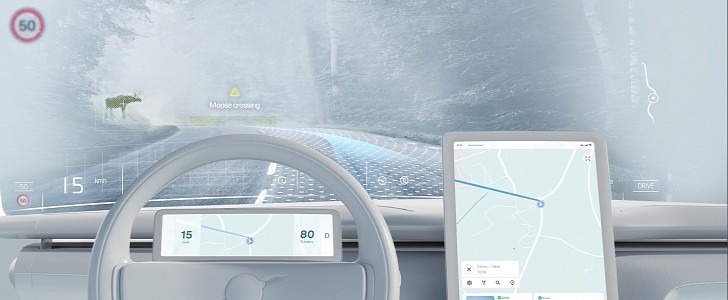Volvo's tech venture arm, called Volvo Cars Tech Fund, has invested $2 million into a start-up company called Spectralics. The goal of the investment is to accelerate the development of optical film technology that could make vehicles safer.
The technology that Spectralics showcased is described as a "multi-layered thin combiner," but you can think of it as a see-through film that can be fitted to a windshield and then used as a screen for an advanced head-up display system. According to the company, the tech can be used to offer a wider field of view, along with a sense of distance.
Spectralics is a start-up company that is an alum of MobilityXlab, a Swedish accelerator located in Göteborg. The same firm is part of a mobility hub in Tel Aviv that connects automotive industry investors with start-up companies. This story is proof that the latter works as intended.
Current Head-up Display systems use just a small area of the windshield, directly in front of the driver, but the new tech developed by Spectralics would have the entire windshield at its disposal. And since it would have such a large surface, it could be used for an augmented reality overlay.
The best analogy for this technology is Google Maps' Live View, which involves raising your smartphone and pointing it at surrounding buildings to allow you to see an augmented-reality view of the area you want to navigate. With Spectralics' technology, this could happen in a vehicle without having to hold a smartphone in front of your face.
It is clear that Volvo has considered using this technology in its future vehicles. With it, the driver could be warned of possible roadside hazards, such as pedestrians on dark roads, or even wild animals that might run into the road at a moment's notice.
Unfortunately, it is unclear when the technology will be ready for production, but we would have to wait a few years until it will be fully developed and available in showrooms. Once that happens, the technology will still have to become useful, unobtrusive, and affordable.
Spectralics is a start-up company that is an alum of MobilityXlab, a Swedish accelerator located in Göteborg. The same firm is part of a mobility hub in Tel Aviv that connects automotive industry investors with start-up companies. This story is proof that the latter works as intended.
Current Head-up Display systems use just a small area of the windshield, directly in front of the driver, but the new tech developed by Spectralics would have the entire windshield at its disposal. And since it would have such a large surface, it could be used for an augmented reality overlay.
The best analogy for this technology is Google Maps' Live View, which involves raising your smartphone and pointing it at surrounding buildings to allow you to see an augmented-reality view of the area you want to navigate. With Spectralics' technology, this could happen in a vehicle without having to hold a smartphone in front of your face.
It is clear that Volvo has considered using this technology in its future vehicles. With it, the driver could be warned of possible roadside hazards, such as pedestrians on dark roads, or even wild animals that might run into the road at a moment's notice.
Unfortunately, it is unclear when the technology will be ready for production, but we would have to wait a few years until it will be fully developed and available in showrooms. Once that happens, the technology will still have to become useful, unobtrusive, and affordable.











